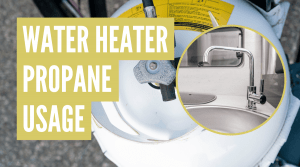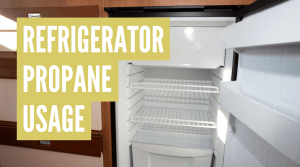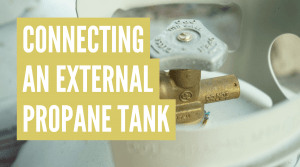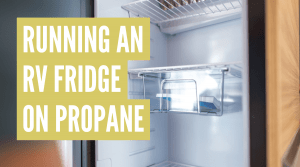Camper FAQs is reader-supported. Buying through links on our site may earn us an affiliate commission. As an Amazon Associate I earn from qualifying purchases.
If you rely on propane to heat your RV in the cold, you need to plan accordingly and bring enough to power your furnace (and other gas-powered appliances).
So, let’s find out how much propane your RV furnace uses, along with some effective tips to increase the efficiency of your furnace.
How to Calculate the Propane Usage for Your RV Furnace
Begin with finding the British Thermal Units (BTUs) of your furnace. If you don’t know your furnace’s BTU rating, then check the owner’s manual or contact the manufacturer. Once you know this rating, we can begin calculating.
To make this easier to understand, let’s look at a real-life example using the Suburban Dynatrail NT-30 RV Furnace, which has a 30,000 BTU rating.
Our RV furnace is rated at 30,000 BTUs, while a gallon of propane has 91,502 BTUs. This means that one gallon of propane will fuel your RV furnace for roughly 3 hours of continuous operation.
However, you probably won’t run your furnace continuously for 3 hours. You might start it just once or twice every hour to maintain the temperature that you’ve set on your thermostat. Let’s understand this with an example.
If your furnace works four times an hour for two minutes each time, this means you are using it for 8 minutes total per hour. Now, for how many hours can one gallon of propane gas last? It’s pretty straightforward; it will supply you with around 23 hours a day, right? Or, you can say it will last approximately one day. So, if your RV furnace has a 20-gallon propane tank, which only holds around 4.5 gallons of actual propane, the tank should last you approximately 4 and a half days (assuming your furnace is the only propane-powered appliance you are running).
Tip: If math isn’t your thing, check out our RV propane usage calculator in our popular guide titled How Long Does Propane Last in an RV. This guide will help you calculate the propane usage of all of your RV appliances.
Apart from the furnace, your RV is likely equipped with other appliances, like a stove, RV refrigerator, oven, water heater, air conditioner, another furnace (yes, some larger RV’s have multiple propane furnaces), and so on. Take some time to understand which appliances need electricity and propane for energy. This will, in turn, help you to evaluate the amount of propane you will need more precisely.
Some helpful resources include:
And keep in mind these are all going to be estimations. There’s really no way of knowing how often your furnace is going to kick on or how long it’s going to run. So, if you are relying on LP as your only source of fuel, keep a close eye on your propane tank gauge. And it’s a good idea to bring along backup propane tanks in case you run out.

DOZYANT Propane Tank Gauge Level Indicator
Price:Clicking this link to make a purchase may earn us a commission at no additional cost to you.
How to Increase RV Furnace Efficiency
While motorhomes and travel trailers are typically smaller and require less of an energy demand than a modern home, they typically aren’t insulated as well and incur energy costs to keep your living space comfortable.
To save on these energy costs (and extend the length your propane tank will last), you can use these tips to increase the efficiency of heating your camper.
- Keep your RV well-insulated – You can expect to maintain more heat with proper insulation. In other words, if your RV is well-insulated, it will retain heat for a longer time. This means you don’t need to turn on the heating system often, which will eventually contribute to a reduction in propane gas use. This can include using RV skirting, using window insulation kits, replacing the old insulation in your RV, and so on.
- Avoid air leaks – Keep your RV warm by minimizing any cool breeze that enters. The most common way of doing this is to seal around the doors and windows. Additionally, the window shades that are insulated and the draft guards can also prove efficient in avoiding air leaks.
- Adjust your thermostat setting – You can lower your heat costs by changing your thermostat temperature if you’re on outings away from the campsite. You don’t need to keep your RV warm when no one is using it, right? Also, consider using winter-friendly bedding and layer your clothes in a way that allows you to lower the thermostat setting during the night.
- Consider using a ceiling fan – Ceiling fans can cool your rooms in summer, but they can also keep the hot air circulating during winter. So, if you turn your fan to a reverse mode, it will push the hot air from the ceiling back down into the room. This can keep you warm and prevent the temperature from going below your set thermostat temperature for a long time.
- Clean your RV furnace at regular intervals – Keep your propane detector clean and be sure to test the propane detector regularly. Check outside the vent for soot and avoid blocking the airflow. Keep your vents clean and dust-free. Carry out regular maintenance of the system by a certified technician. Check out our guide titled How Does an RV Propane Furnace Work to better understand your furnace and for some important maintenance tips!
- Use the sun – Parking your motorhome in direct sunlight as opposed to the shade will help heat your vehicle during the day.
Are There Any Alternatives to Using Propane Gas?
Yes! It’s a safe practice to have a contingency plan in case the furnace stops working, your RV propane stops flowing, or you’re out of propane gas. Going with any of the alternatives below can serve your purpose as a substitute RV heater:
- Space Heaters: Heaters are a perfect option to heat small spaces like campers and travel trailers. Opt for a portable heater, like a compact and lightweight electric heater. However, choose one that is safe and meets your heating needs. Check out our guide on the best electric heaters for RV use to find a high-quality, safe heater.
- Electric Fireplaces: Some RVs have electric fireplaces. They serve a dual purpose of heating the space as an electric heater as well as elevating the ambiance. If your RV does not have one, choose from many compact options available on the market as a portable heater.
- Electric Blankets: Additionally, an electric blanket can serve you as an electric heat source. Using it can keep you warm enough to spend the night comfortably.







Write a comment